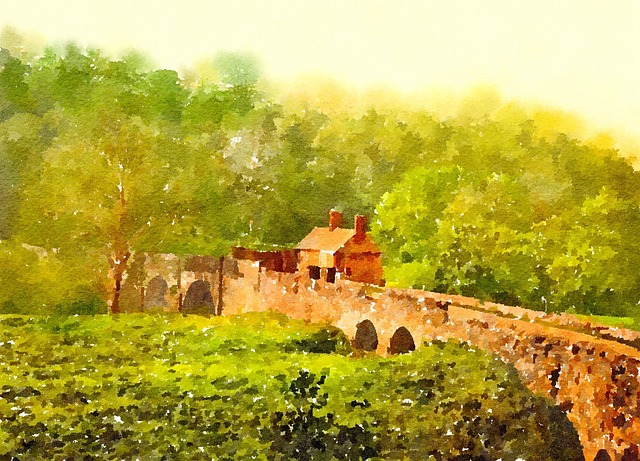
The Derbyshire countryside, in England’s East Midlands, is a region that has inspired writers – both classic and contemporary. The juxtaposition of rolling hills, stark moorland and craggy summits play backdrop to numerous novels in a variety of genres.
The area is easily reached from a number of large cities – but parts are incredibly remote. The Peak District and Derbyshire Dales, in particular, are popular with hikers, artists and families alike.
Here are five novels to read if you are visiting that will really bring the beauty and complexity of the the Derbyshire countryside alive.
Pride and Prejudice – Jane Austen
I believe I must date it from my first seeing his beautiful grounds at Pemberley…
So Elizabeth Bennett facetiously attributes the beginnings of her romance with the famously proud and reticent Mr Darcy in Austen’s classic tale of misunderstanding and redemption. Pemberley, Darcy’s ancestral home, is based on Chatsworth House, the stately home built and owned by Duke of Devonshire near the picturesque town of Bakewell.
Elizabeth’s tour of Pemberley with her aunt and uncle can easily be imagined on a trip to Chatsworth house. It is a grand old building with a storied history of its own. It is, however, very proud of its connections with Austen and a bust of Darcy from the 2005 adaptation of Pride and Prejudice can be seen on your visit.
The house’s extensive grounds are also exquisite, as it lies along a beautiful sweep of the River Derwent. Bakewell is also worth a visit as it is thought that Austen wrote part of Pride and Prejudice novel while staying in the town. A plaque at The Rutland Arms pub commemorates her stay.
Reservoir 13 – Jon McGregor
From the top of the moor when people turned they could see the village: the beech wood and the allotments, the church tower and the cricket ground, the river and the quarry…
Winner of the 2017 Costa Book Award, this tense and brooding novel is set in an unnamed Peak District village. The plot follows the inhabitants of the village in the years after a young girl on holiday with her family goes missing. The disappearance of the girl is a common event which ties together numerous characters whose stories reflect both the support and stifling atmosphere of small village life.
The reservoirs detailed in the book are reminiscent of areas of the Dark Peak, described as the “higher and wilder” part of Derbyshire’s Peak District. Ladybower reservoir is particularly stunning, and near to both moorland and woodland in which it can be imagined that one could go missing. The scenes of farming on quadbikes in the moors, the descriptions of the village pub, and the boredom of teenagers misbehaving on the moors can be easily be envisaged.
Jane Eyre – Charlotte Bronte
Finding a moss-blackened granite crag in a hidden angle, I saw down under it. High banks of moor were about me; the crag protected me: the sky was over that.
In this classic gothic tale, Bronte’s plain but spirited heroine becomes a governess at Thornfield Hall. Her burgeoning love for her employer, Edward Rochester, is marred by strange happenings in the night. Thornfield has a secret.
The hall itself is based on North Lees Hall near Hathersage in the Peak District. You can follow a Jane Eyre trail which includes nearby Stanage Edge, an awe-inspiring rock formation with incredible views across the moors. The moorland is recognisable in descriptions of Jane’s desperation and near-starvation after she discovers Rochester’s hidden past and flees Thornfield.
Adam Bede – George Eliot
Look at the canals, an’ th’ aqueduc’s, an’ th’ coal-pit engines, and Arkwright’s mills there at Cromford…”
Adam Bede follows the lives of characters in rural Derbyshire in 1799 and was written following a visit Eliot paid to her aunt and uncle in Wirksworth. Eliot’s aunt, Elizabeth Evans, a Methodist preacher, recounted a story of a visit she had made to comfort a woman convicted of infanticide. Although dismissive of claims that her characters were solely based on her visit, Eliot acknowledged her aunt’s role in planting the “germ” of her novel.
This inspiration is seen in the book’s heroine Dinah Morris – also a methodist preacher – and the ill-fated Hetty Sorrel, who falls pregnant out of wedlock. The industrial landscape of Eliot’s setting Stoneyfield is clearly recognisable in Wirksworth’s surroundings, and both Cromford Canal and Arkwright’s Mill can be visited.
The Wintry Peacock – D. H. Lawrence
I went outside, and saw the valley all white and ghastly below me, the trees black and thin looking like wire…”
Lawrence moved to Middleton-by-Wirksworth after leaving Zennor in Cornwall in 1918, where Lawrence and his wife Frieda had encountered unpleasantness due to Frieda’s German heritage under the shadow of the first world war. In letters written to friends, Lawrence’s discontent is clear. He feels he has been forced into exile, made worse by the bitter winter and barren landscape.
Feelings of isolation are reflected in his descriptions of the countryside in The Wintry Peacock. Set in the valley Lawrence’s cottage overlooked, his protagonist encounters a lonely and unhappy wife whose absent military husband has received a love-letter from a woman abroad.
By:
- Heather Green PhD Candidate, Literary Heritage, Nottingham Trent University
Disclosure statement
Heather Green works for Wirksworth Heritage Centre in Wirksworth, Derbyshire.
This post was originally published at The Conversation.









